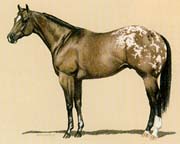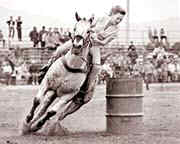

Appaloosa


Introduction: If you have any comments or suggestions, please click here. The picture of the barrel racer is of a horse named Joker B.
Names: Appaloosa, sometimes called the American Appaloosa. The name Appaloosa is probably a corruption of "A Palouse horse," taken from the Palouse River that runs through northeastern Oregon in the United States and the surrounding countryside of the same name.
Origin: The
Appaloosa originated its coloring in Spain and was later developed as a war
horse by the Nez Perce Indians in the Palouse area of northern Idaho and
northeastern Oregon, one of the few Indian tribes to breed horses selectively.
Chief Joseph and his Nez Perce tribe
were subjugated by the Government in 1877, after a long retreat from their home
territory. The breeders of the Appaloosa had taken flight with about 2,000
of their excellent horses. Some 900 of the animals drowned in the fording
of the Snake River and those remaining were taken by the Army and eventually
sold off. Appaloosas left behind on the range were acquired by settlers or
turned wild.
What saved the Appaloosa as a breed was its spotted hide, a
feature valued by circuses and Wild West shows. A few breeders continued
to produce Appaloosas to meet this demand, but, until 1936, the breed was always
dangerously close to dissolution. In that year, Dr. Francis Haines,
authority on the breed, published an article, "The Appaloosa or Palouse
Horse," which attracted wide attention. In 1937 the Appaloosa Horse
Club was formed. Its membership passed the 30,000 mark in 1971.
Tracing the origin of the breed is a continuing project of
the club. As reported in its 72-page monthly magazine, evidence of spotted
forebears of the Appaloosa has been found in the art of ancient China, in the
epic literature of Korea, Japan, India, and Persia, and in Etruscan
artifacts. Spotted horses were common in Britain in the 15th century.
Breeding: One old source states the breeding area as the western states of U.S.A. and Canada, particularly Alberta, and mentions after the latter the Cru-Indians. The Appaloosa is descended from horses originally brought to America by Spanish conquistadores, stolen by the Indians--particularly the Nez Perce (Pierced Nose)--and reared as their own breed.
Description: Meriwether Lewis described the horses of the Nez Perce as "an excellent race . . . eligantly [sic] formed, active and durable; many of them look like fine English coursers."
Body: Rugged, short-coupled, muscular build. High-set neck; deep, very narrow chest; long, sloping shoulders; straight back; strong, rounded croup with tail set high.
Coat: Silky. The spots are "embossed" and can be felt.
Color: There seems
to be some disagreement about the number of acceptable color types. One
source stated six or so variations of coat pattern are permissible.
Another named three main color types--dark pinkish with lighter back and black spots on loins and hips;
white with black spots; bay or black with white spots on hips and loins.
Another, fairly old source named four main types of pattern and listed them in
some detail which I include below.
First, the blanket-pattern, whose forepart is usually
coloured red or dark brown, while the hindquarters, particularly in the region
of the loins and croup are covered with numerous dark, round or oval, spots
spread evenly over a white background. Then there is the
snowflake-pattern, which is dark colour all over with only a few white speckles
over the loins and croup. The third type is the leopard -pattern, mostly
white, light grey or cream and covered all over with dark spots. Finally
there is the spotted-pattern, usually brown, with single round or oval white
spots sometimes fairly sharply defined, often irregular.
With these four patterns, the following is noted in various
sources: that large blazes and stars, often broken by prominent dark spots are
common; also differently coloured hooves, usually striped with vertical dark and
light bands; and that the Appaloosa also usually has pink skin, mottled in any
number of acceptable patterns, but especially about the nostrils, and the eye
must be encircled by white.
Hair: One of the most prominent features of the breed is the short, thin mane and tail, which might be described as a fringe. This has a silkiness almost surpassing that of the Oriental Thoroughbred.
Head: Broad and straight with large, lively eyes, showing lots of white, and rather small, pointed ears.
Size: 14-15.3 hands. Not less than 14 hands in height. Another source states 14.1 to 15.1 hands.
Temperament: Very willing and docile; extremely friendly and quiet nature. The general impression is harmonious and quiet.
Features: Fast riding horse with plenty of stamina. Belongs to the "Western Horse" groups (whatever that means; stated in a rather old source). Considerable galloping capacity and jumping ability.
Uses: Cow pony, hunter and jumper. Much liked as circus horse.
Accomplishments:
Curiosities: There were spotted horses in China 3,000 years ago, and "leopard-marked" horses, said to have originated on the Arabian coasts, spread as far as India. In the Arabic version of his vision, Zacharias describes the horses "which went south all over the world" as "leopard spotted."
Profiles:
Conclusion: